
CHEROKEE VILLAGE, ARKANSAS: LAKE MANAGEMENT REPORT
INTIAL EVALUATION- Report dated May, 28th 2024
The following report is a preliminary detailed look at the existing conditions of the
Cherokee Village Arkansas lakes. It is broken down into seven main categories
that cover some of the primary management issues facing all of the lakes here in
Cherokee Village. Its purpose is to provide the necessary preliminary information
regarding the current conditions and future needs of the lakes and begin the
process of creating a sufficient operating budget for the future. Lake management
is an ongoing, long-term endeavor and we recommend planning, budgeting, and
implementing the program over the next 10 years, while continuing to monitor
and amend the plan as needed as you progress.
Lake Descriptions:
NAME
ACERAGE/TYPE
DEPTH
SHORELINE
Lake Aztec
21.024 Acres/Fishing
Max 40 Feet
.987 Miles
Lake Chanute
55.612 Acres/Fishing
Max 40 Feet
2.273 Miles
Lake Cherokee
37 Acres/Fishing
Max 40 Feet
1.416 Miles
Lake Navajo
34 Acres/Fishing
Max 25 ft at Dam
1.06 Miles
Lake Omaha
142.216
Acres/Fishing,
Boating, Skiing
Max 40 ft at Dam
4.7 Miles
Lake Sequoyah
75.5 Acres/Fishing,
Boating
Max 55 ft at Dam
2.361 Miles
Lake Thunderbird
264 Acres/Fishing,
Boating, Skiing
Max 75 ft at Dam
Avg 25 Feet
7.2 Miles
DAMS: Obviously the dams are an extremely important part of the lake
management program, and its maintenance is regulated by the state. Although
these Dams have all been recently inspected by the S.I.D. staff, we have also
briefly inspected all seven dams and have observed the following potential issues:
Significant leaking on the downstream slope of Lake Sequoyah.
Some unwanted tree saplings and vegetation in isolated areas of several Dam
slopes.
Multiple animal burrows along with other holes and surface irregularities.
Keeping both the upstream face and the downstream face of each dam well
maintained is critical to the long range management plan. Allowing trees,
burrowing animals or erosion issues to go unchecked can lead to future issues
with the overall integrity of the dams.
Regular inspections are necessary to monitor these potential negative issues.
Regular mowing and tree removal is necessary. Properly timed and approved
Herbicide and Growth Regulators, applied by a licensed applicator, will also be an
important part of the management program needed to properly maintain these
dams.
Specialized Outdoor Services can provide quotes for Herbicide and Growth
Regulators and/or Mowing Services as needed.
LAUNCH RAMPS: The boat launch ramps are certainly outdated and quite narrow
and short. Some are in need of repair to the concrete. Parking is limited in most
situations. However, with the small size of some of the lakes, increased parking
areas are probably not too important overall. Repairing deteriorated concrete,
enlarging the ramp itself or increasing parking should be future considerations
and could be performed during lake level draw downs related to dam repairs
and/or dredging operations.
SEDIMENT MANAGEMENT: This is a major concern for the lakes and has been
overlooked for decades. Large amounts of silt and organic matter have been
flowing into the lakes unchecked for 50 years or more, depending on the
individual lake. This sediment is detrimental to the overall health and condition of
the lakes. This sediment is one of the causes of invasive aquatic vegetation and
algae in lakes. It can tie up large amount of nutrients that can diminish the overall
water quality and lower fish and forage production capacity. It also displaces the
overall water volume and can make some areas so shallow that boat traffic is
limited in certain areas. In some cases it can make boat navigation and access into
docks difficult and eventually impossible. It also diminishes recreational uses,
such as swimming. In addition, this sediment is detrimental to game fish
populations as these fish require a hard bottom to successfully build their
spawning beds and produce fry each year. Although the “Average Sediment
Depth’s” are less than I expected, the current sediment depth is limiting game fish
production as well as some of the forage fish production.
We have done extensive depth checking of the sediment in each lake and have
mapped out some of the areas that are most affected. Although there is sediment
in all of the lake bottoms, we have focused on the inflows, around marinas, parks
and boat ramps for this initial evaluation.
Some areas have a substantial amount of rock and gravel mixed into the sediment
and other areas are more silt and organic debris without much rock or gravel
mixed in it.
Unfortunately, this will be one of the most difficult, time consuming and costly
parts of the future lake management issues in Cherokee Village.
Dredging is the only way to remove this unwanted material and can be a very
extensive process. I have been involved in several methods of dredging and have
observed a considerable amount of dredging operations and methods. Most
dredging operations tend to revolve around the concept that they will be
completely removing all the sediment down to the hard pan within certain
selected, generally broad areas.
Mechanical Dredging using various types of dredging equipment is the most
common method used in these types of lakes.
Hydraulic Dredging is used when accessing the lakes and is an issue for the
equipment that’s used in most mechanical operations.
Accessing our lakes will be a challenge due to the lack of common property suited
to bring the necessary land equipment and material in and out of the lake
bottom. In that situation, hydraulic dredging from a floating barge is the common
recommendation. It requires that the material collected be put into large,
perforated bags that will drain out the water. Then these bags are offloaded from
the collection barge and stockpiled along the lakeshore and /or Dam for removal
when dried. Then generally another contractor is required to haul the material
out, unless it can be accomplished with S.I.D. employees and equipment.
Hydraulic dredging is going to be the most expensive method and will require out-
of-state contractors. In most cases, you will end up on a long waiting list. The last
200 acre lake in Arkansas that I know of, who contracted a hydraulic dredging
contractor, spent over $500,000.00. And the contractor went way past the
projected time of completion. Although this method can be very effective in many
situations, it may not be feasible here at this time.
Mechanical dredging will be somewhat less costly and easier to find contractors
or own the necessary equipment. However, accessing the lakes will be an issue as
well as stockpiling the material removed. Without common areas that are
practical (not too steep or heavily wooded) to bring equipment and material in
and out, it will be a very long and limited process and will increase cost. And the
material we haul out will require months to dry out along the lakeshore
somewhere, before it can be hauled away. The cost of this process would be
calculated and quoted by most contractors based on the cubic yards of material
removed from the lake bottom. Due to the time considerations of this process,
multiple contractors are usually required to complete the process in a timely
manner.
Lake Drawdown: The mechanical dredging process will require a drawdown of
the lakes. Based on our findings we would need to have access out to the 6-10
foot contour lines to make any significant differences. This would require
lowering the lakes down 8-12 feet to be able to access the target areas with
bulldozers, track hoes, backhoes, skid loaders and small dump trucks. This process
will take approximately 1 month to lower the lake, 1-2 months to dry out the
bottom enough to work in it, 1-2 months to remove material and 1 to 2 months to
refill the lake. All of this is dependent upon the total area selected to dredge and
the depth of material removed as well as the amount of precipitation received
during the entire process, which can make the project timeframe vary
significantly in either direction.
Generally, a schedule of lowering the lake beginning in late September or early
October, working through the late fall and winter is the best strategy to plan for.
Then we would normally receive enough precipitation in March, April and May to
refill the lake.
This basic mechanical method of dredging would be feasible for the most part
here, but still difficult due to the limited access and the areas available to
stockpile the material removed.
Recommendations: After assessing the situation here in Cherokee Village, I
would make the following recommendations for a long-term dredging plan. I
would advise a targeted approach in order to get the most benefit from your
budget and remove the most amount of material where it is needed. This
approach will also widen your available timeframe, allow more flexibility, and
reduce the overall inconvenience to the property owners.
I recommend scheduling each lake for drawdown every seven years. In your
situation, that puts each lake lowered and dredged as needed once every eight
years. This would also allow homeowners to address any concerns they have with
their shoreline property needs or dock repairs, etc., within the guidelines of the
S.I.D. However, with the following method, the lakes would not have to be
lowered out to the 8-12 foot contour lines. Lowering the lakes to the 6-8 foot
contour would be sufficient in most of the lakes.
I recommend using a combination of conventional excavating equipment where
accessible, preferably utilizing this equipment working in the larger areas within
the inlet creeks and larger flat coves, if access is obtainable.
The remainder of the dredging along the lake shoreline would be targeted
specifically around docks, marinas, parks and boat ramps using an Amphibious
Excavator. This will allow you to target these areas, precisely and as specifically
as needed. It will also help reduce the overall total cubic yards of material
removed, thus reducing cost. This process will make sure each dock has a clear
channel to the deeper water. This will also reduce weed and algae populations in
those areas and increase other recreational activities around the docks, parks and
marinas as well as make vital spawning habitat for game fish, providing ample
cover is available for them. (See fish habitat section). This process will also allow
the entire work timeframe to increase. This equipment can work both on land and
in up to 4-6 feet of water depending on equipment size. The material removal
process can begin before full lake drawdown is achieved and go on well into the
refilling process. The material still has to be loaded on to a floating barge and
then unloaded on shore. Then it will still need drying time before final removal.
This material can be used for other fill needs or projects once it is dry. Or it could
be sold, added to compost, or donated.
With the upcoming repair needed on the Sequoyah dam, a significant lake
drawdown will be required. Scheduling any dredging operations would be best
scheduled to coincide with the dam repair project on that lake.
Specialized Outdoor Services can provide quotes as needed on Amphibious
Excavator dredging or conventional equipment mechanical dredging.
I have attached some maps indicating some of the sediment locations and depths
in the lakes.

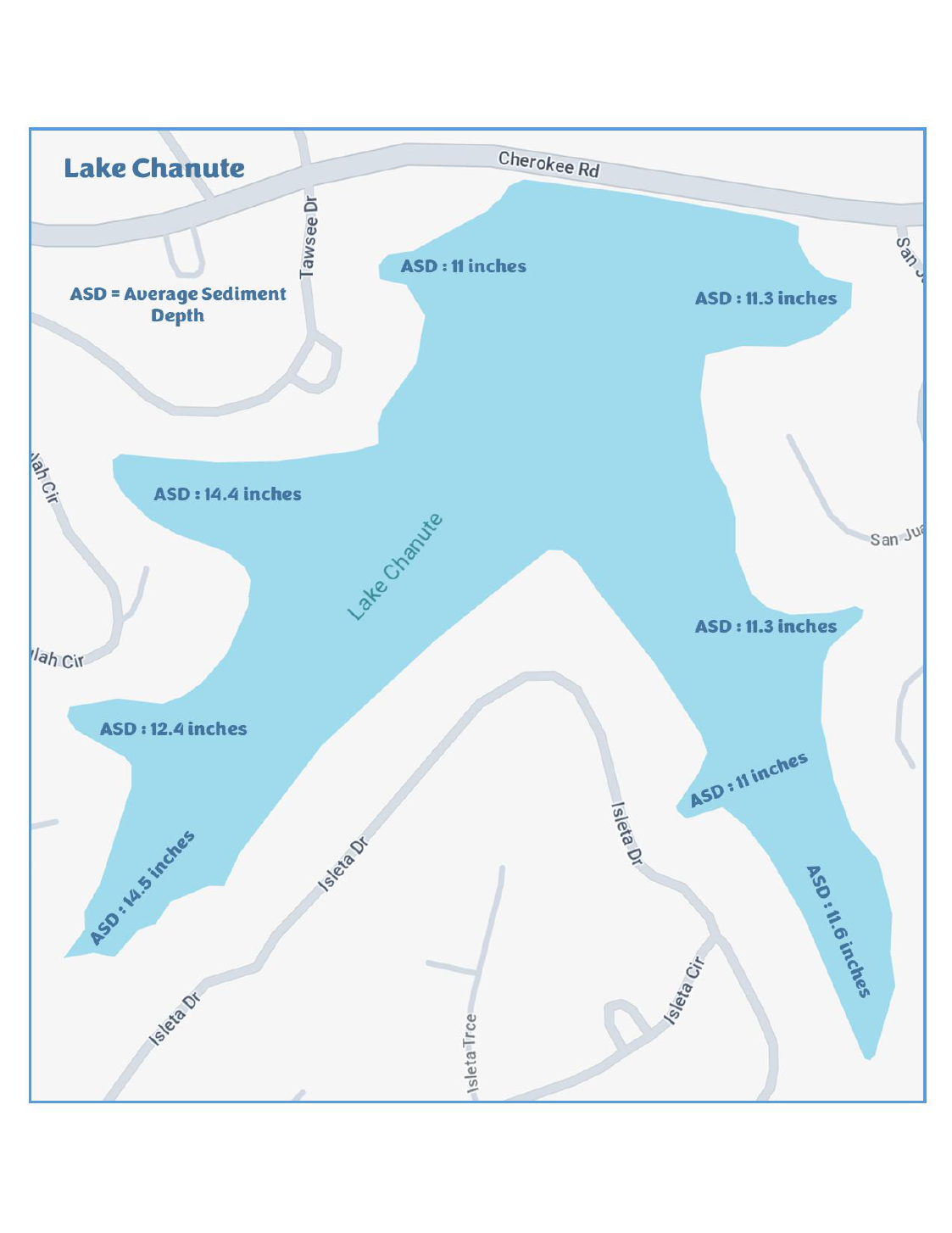
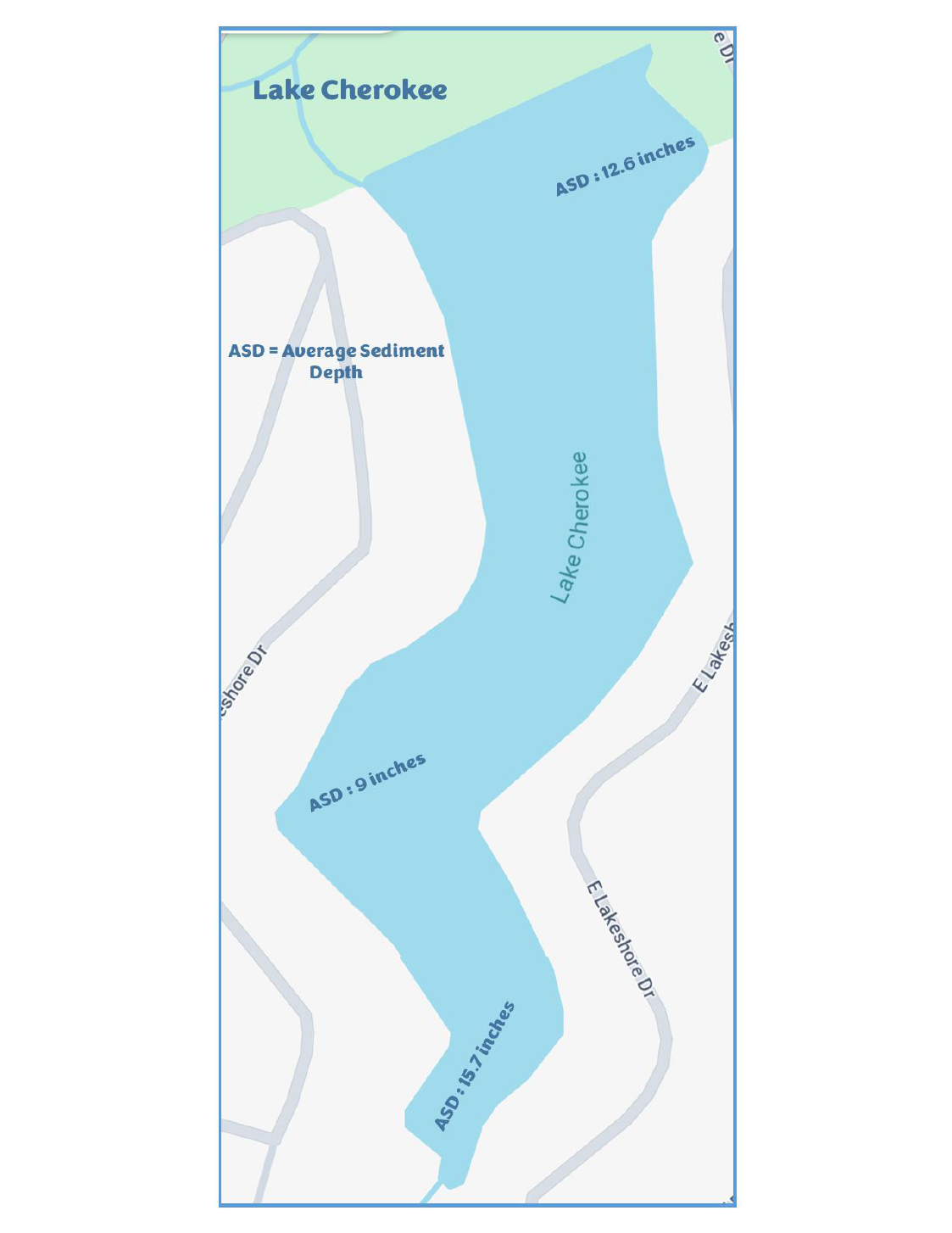

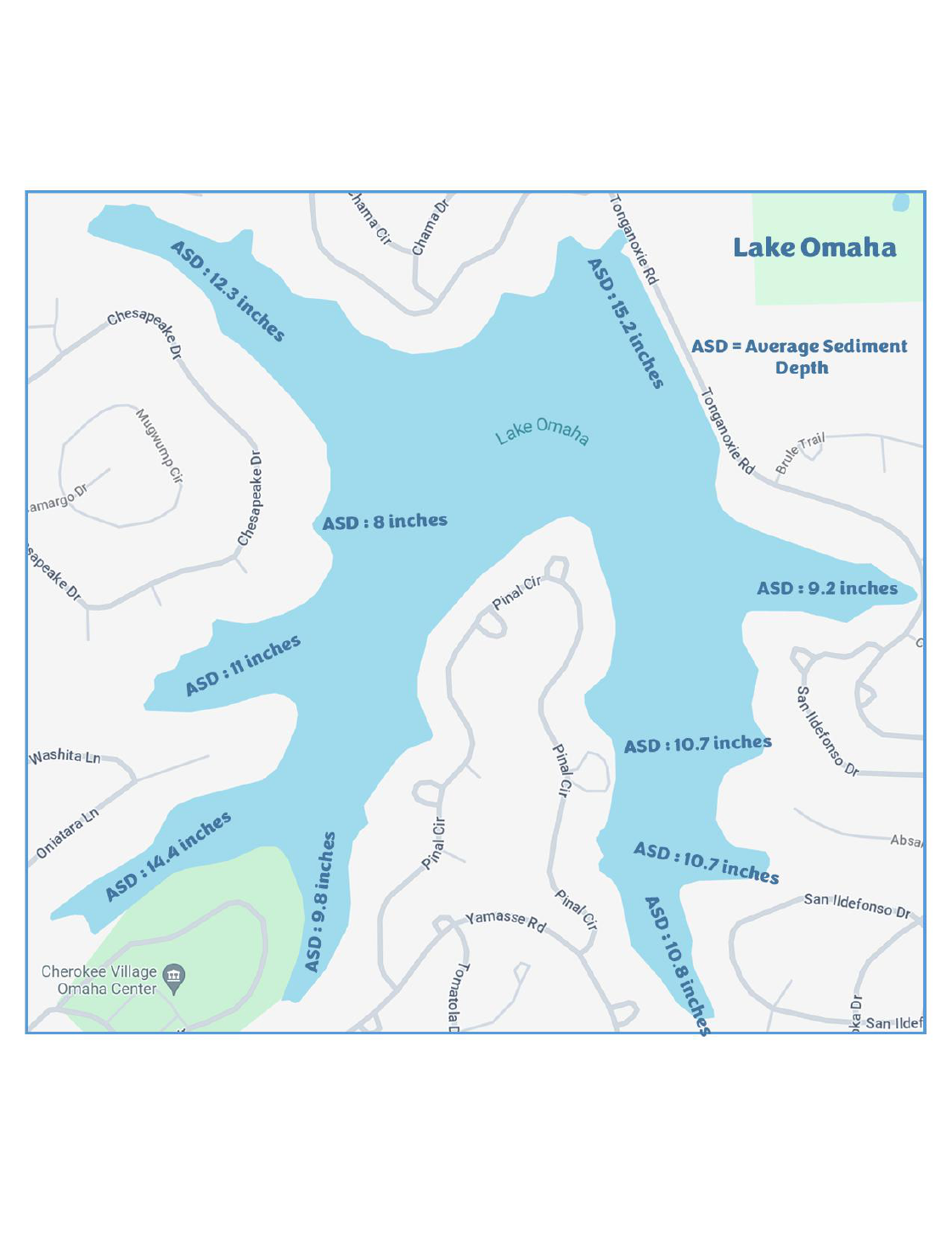
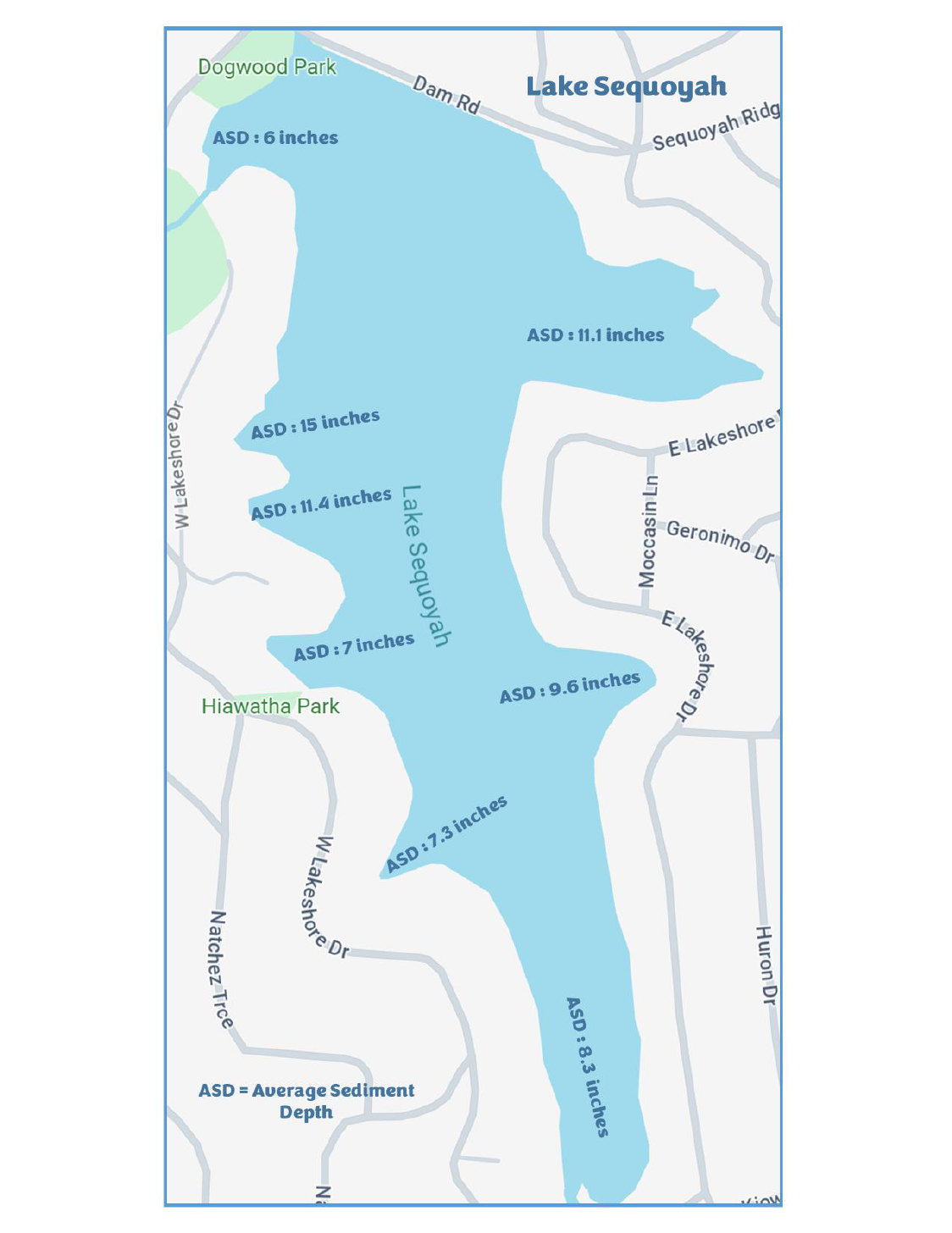

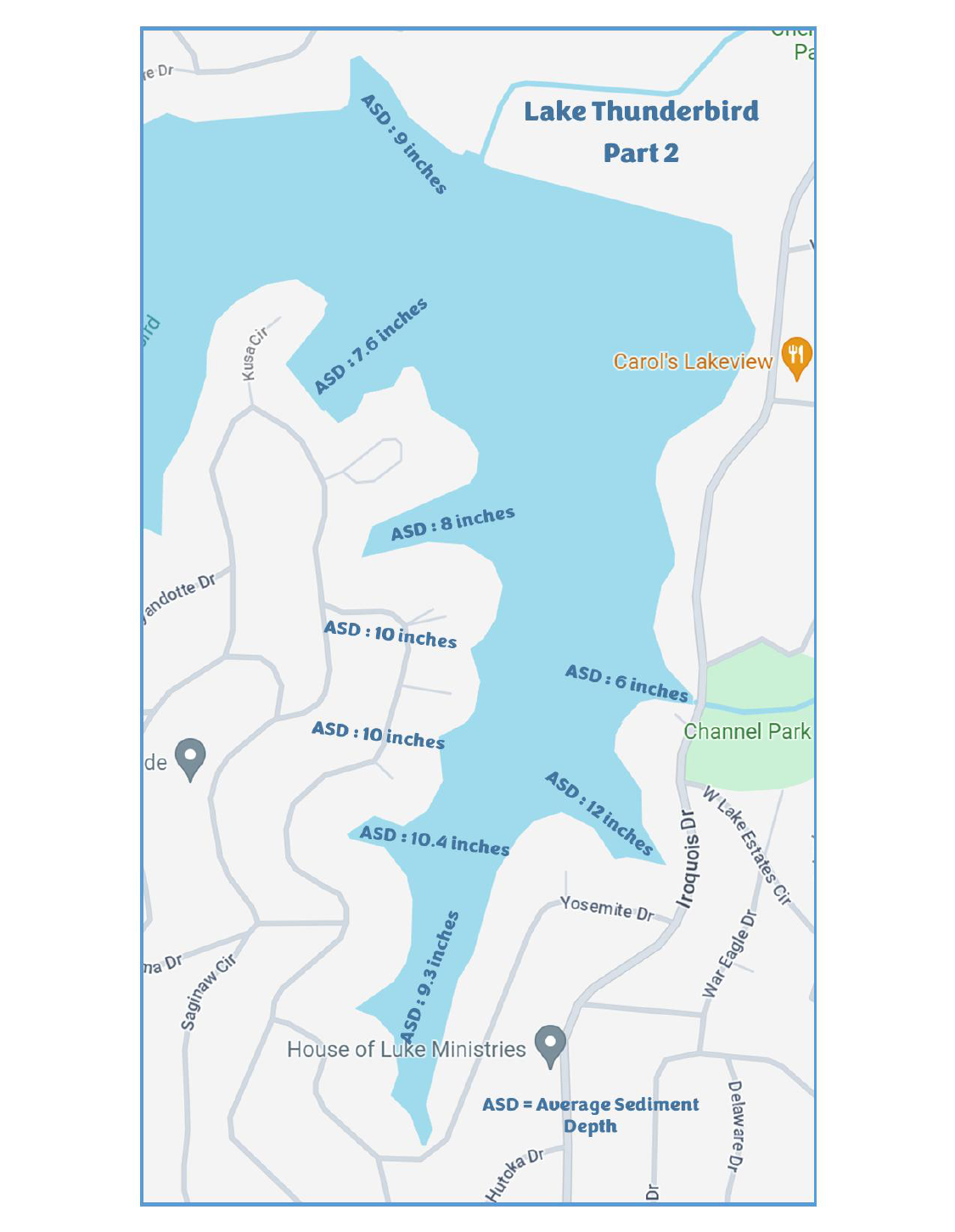
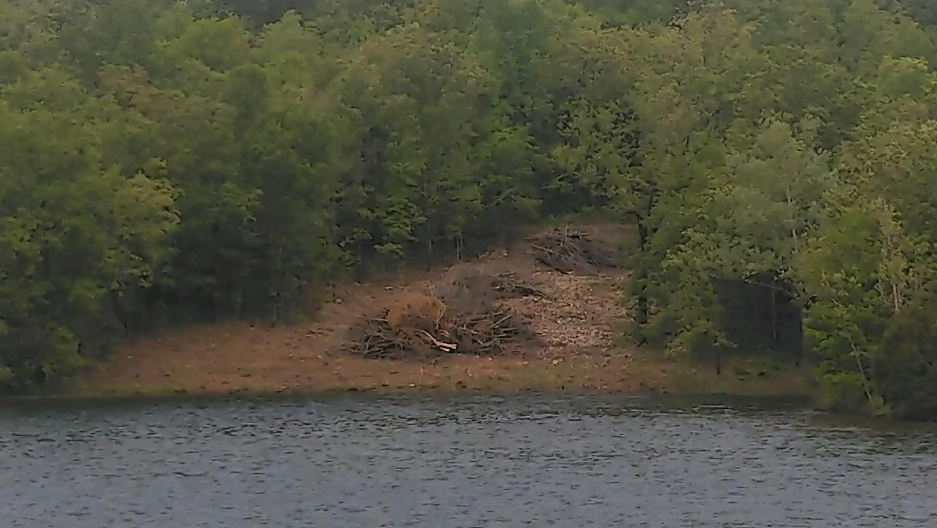
EROSION CONTROL: Controlling erosion around the lake shore is an important
component of managing the sediment coming into the lakes. Construction on the
lake shore needs to be monitored and properly regulated in the form of
mandatory erosion control methods with the approved materials and installation
methods. If not already in place, I would consider implementing mandatory
guidelines for controlling erosion to lake shore construction sites and/or enforcing
rules already in place. The state has some guidelines on this subject if needed.
I have included a picture of a lot cleared this past winter on Omaha and is a great
example of what should not be allowed. This is how more and more sediment will
get into the lakes, and it is one of the few ways erosion happens that you can
control to a large degree.
Specialized Outdoor Services can professionally install or sell erosion control
products if needed.
WATER QUALITY: Each lake has had a basic water test done for Nutrient loads,
PH, Alkalinity, Hardness, Conductivity, Carbonates and Bicarbonates. All of the
Cherokee Village lakes fall within the normal parameters of lakes within this
region and no serious problems exist.
Although none are expected due to the low nutrient loads, we have not tested for
Cyanobacteria at this time. If testing is done, I recommend taking samples during
the warmer months when surface water temperatures are above 80 degrees.
These bacteria can consume oxygen from the lakes, reduce the microorganisms,
promote non beneficial or toxic algae, diminish the food chain and can produce
toxins unsafe for animals and humans. These Cyanobacteria are not normally an
issue on these types of lakes in this region, and I have no reason to believe they
will be a problem in the future.
I have attached the individual laboratory results for each lake to this report.

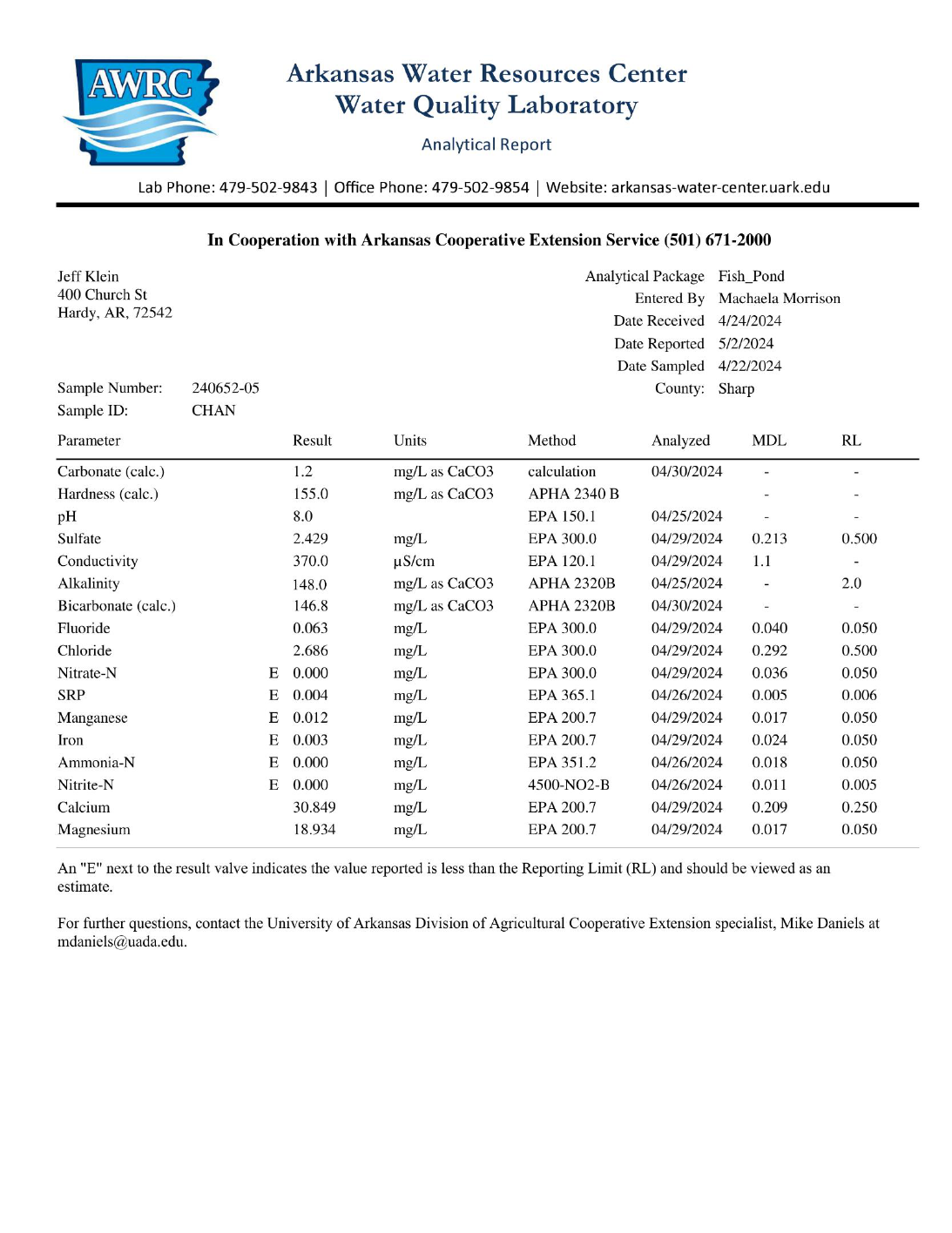
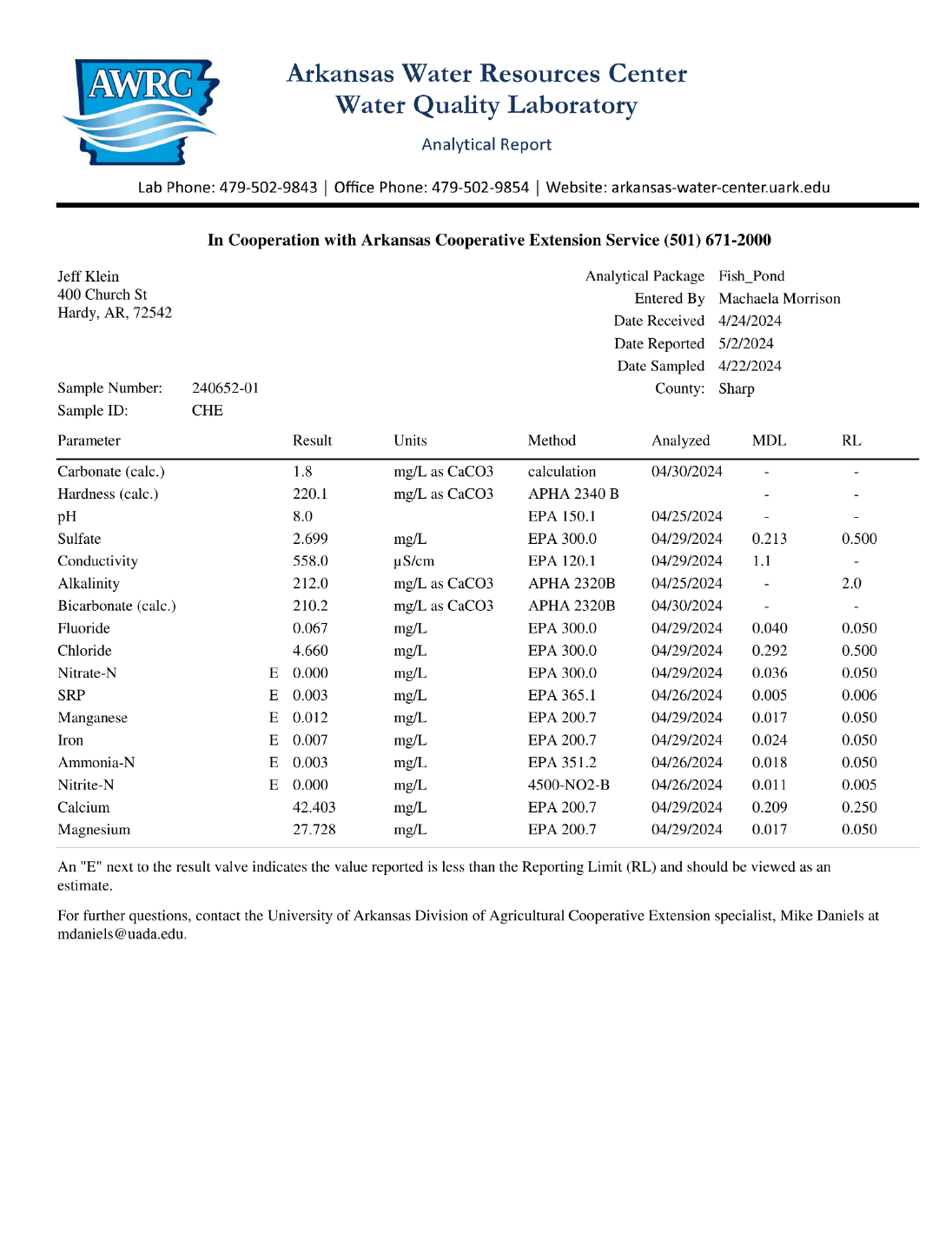
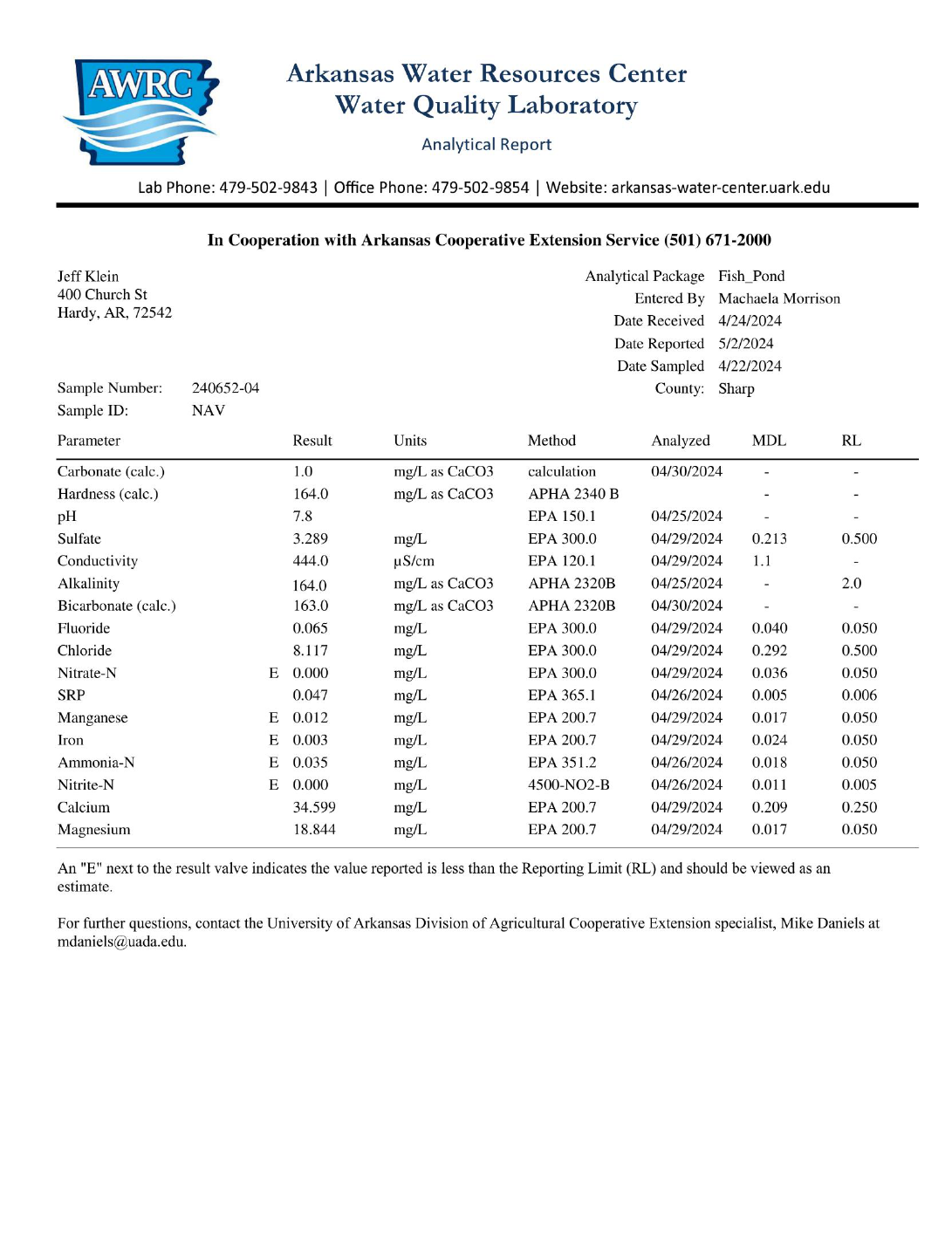
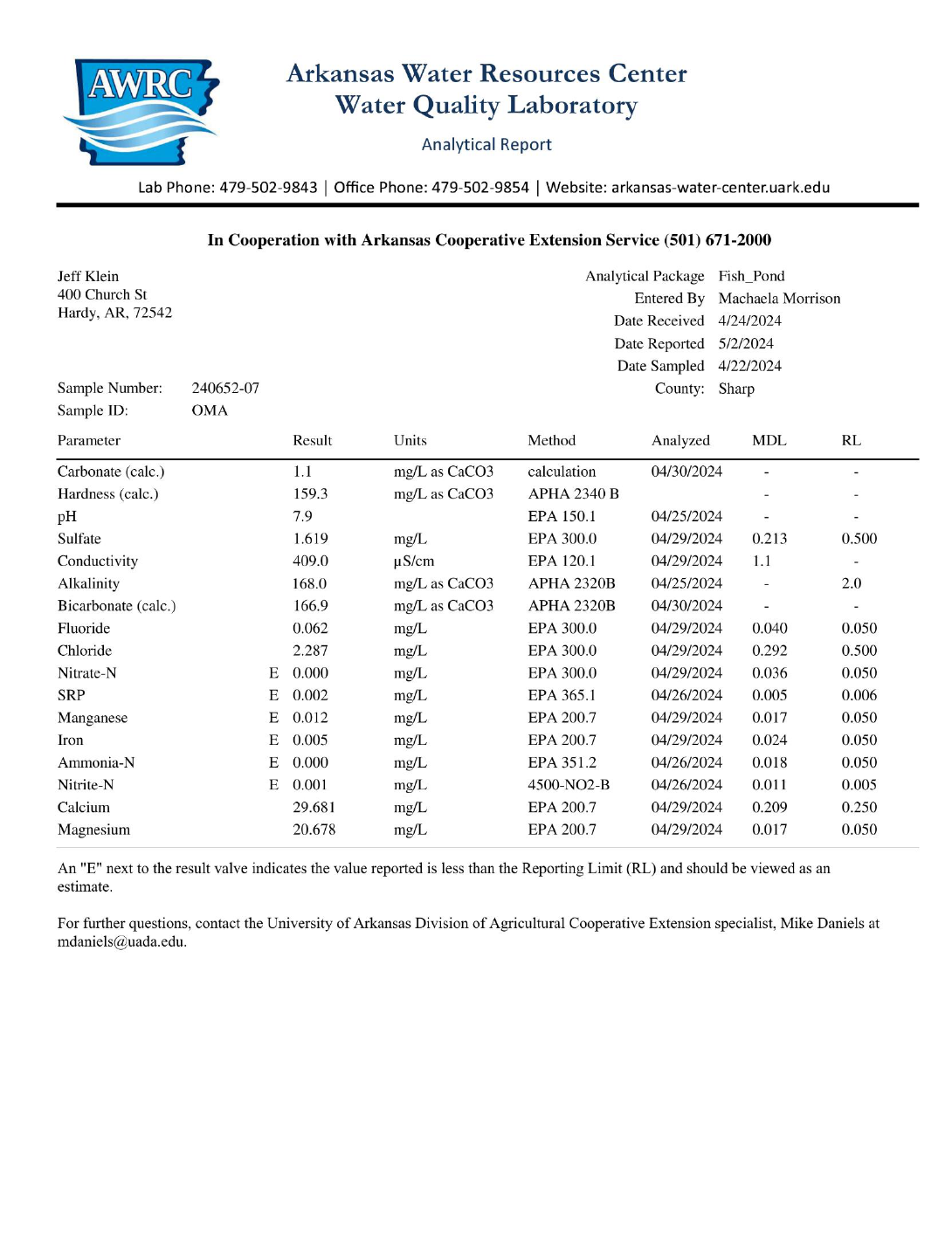
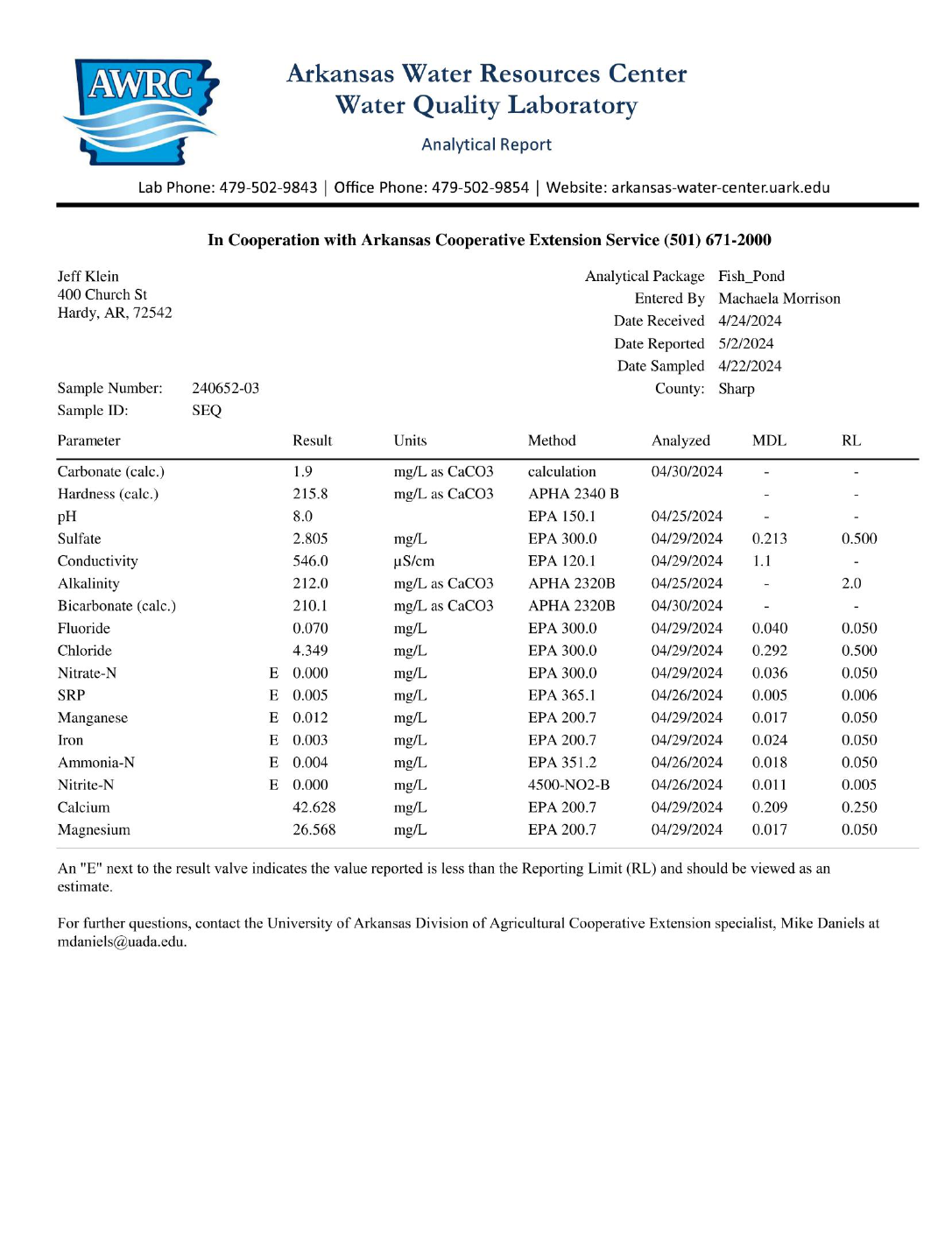
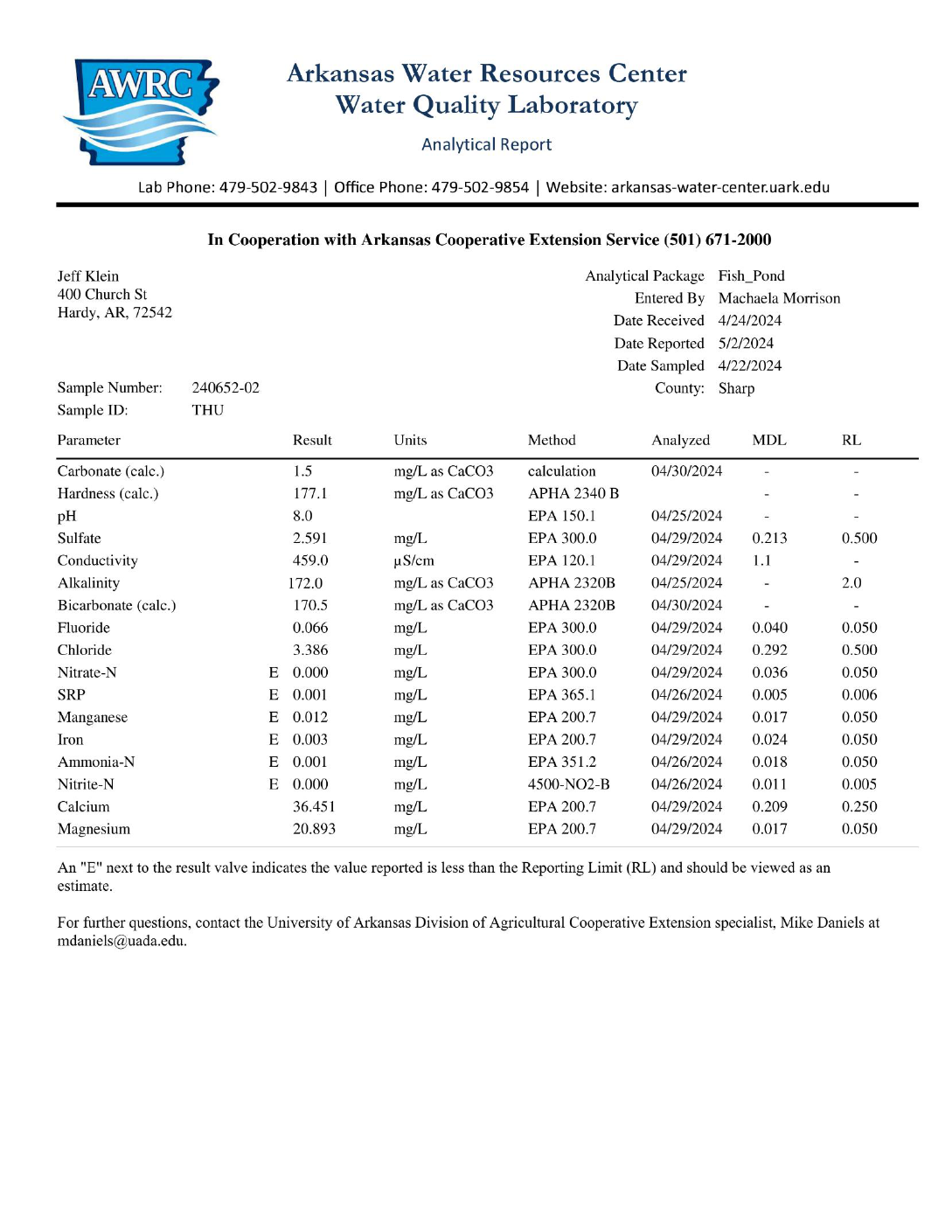
AQUATIC VEGETATION AND ALGAE MANAGEMENT: The lakes in Cherokee
Village do not have a substantial aquatic weed population. However,
management is still necessary to maintain a good balance of beneficial
vegetation, while not allowing them to become overpopulated. If left untreated,
they can overgrow and consume too much oxygen from the lakes, restrict boat
travel, swimming, fishing and other recreational activities as well as become
unsightly.
A selective aquatic weed control program was implemented on all of the lakes in
2023 and will continue in 2024 with some additional areas being included this
year.
The primary plants we have in the lakes are American Water Willow and Water
Lilies. Both do provide several benefits to the lakes. They help stabilize bottom
sediment, consume nutrients from the sediment, stabilize shoreline soils and
provide cover for microorganisms, insects and forage fish as well as cover for
spawning game fish and their fry.
We do have some very isolated areas of Water Primrose as well, and it also does
provide some benefits to the overall eco system of a healthy lake.
The American Water Willow is the most prevalent weed we have and is found
along the shoreline of all of the lakes growing from the shoreline out to as much
as 3 feet of depth.
The Water Lily is not as prevalent, however can be more invasive in nature, due
the fact that it can completely cover the surface of large areas, if left unmanaged.
(In 2022 Lake Cherokee did have a large population on the south end of the lake
that covered about 4 acres in a solid mat. We have cleaned that up and reduced
the population by 95% at this time.).
The proper aquatic weed control program should be selective and balanced.
Allowing as many areas of the lake to support a managed population of beneficial
aquatic vegetation helps promote a healthy lake and productive fishery.
Targeting the areas around docks, parks, Dams and other high use recreational
areas, while allowing the less developed or undeveloped areas to remain intact
and untreated, will provide a good balance for these lakes.
Selecting the proper chemistry, application timing, rates and methods are all
critical to environmental safety and weed control effectiveness, and we do not
recommend allowing unlicensed applicators or property owners to apply any
chemicals to the lakes.
There are several types of algae that occur in the lakes with Chara Algae being the
most abundant. The Chara does have some ecological benefits similar to some
aquatic plants. It does provide some sediment stabilization, cover for small
aquatic animals, invertebrates and forage species as well as small game fish.
Chara also provides food for some fish and waterfowl. However, an over
abundance of this algae can be an issue with oxygen consumption as well
restricting boat navigation, swimming, fishing and other recreational activities.
Another type of algae present in the lakes is Filamentous Algae. These algae grow
in long strands from the lake bottom until eventually trapping gases, breaking
loose and floating to the surface. This generally happens in the mid to late
summer. Although there are some ecological benefits to the lakes food chain
from these algae, an over abundance can become an unsightly nuisance as well as
cause oxygen depletion and in some cases release toxins into the water body.
Both of these types of algae are promoted by excessive nutrients in the sediment
collected on the lake bottom and are extremely difficult and somewhat costly to
control without addressing the sediment issues.
In 2023 we targeted several areas on the lakes and treated multiple times with an
approved Algaecide and will be expanding those treatments in 2024.
We also have some amount of Planktonic Algae, but due to the low amounts of
soluble nutrients in the water column, not enough is present for good fish
production. This is the most beneficial algae we have in the lakes. This algae floats
within the water column and is sometimes confused with dirty water. Planktonic
algae are the base of the food chain. They are fed by zooplankton (microscopic
animals), which in turn, become food for forage fish species. Lakes with abundant
planktonic algae are often able to support large populations of fish that grow
more quickly. This type of algae can be manipulated with precise nutrient
applications to the lakes and will be discussed further in the fisheries
management section of this report.
Some of the lakes aquatic plant and algae issues are promoted by old septic
systems around the lake shores that allow excessive nutrients such as
Phosphorous into the lake and those nutrients settle into the bottom sediment
and encourage weed and algae growth. Although, neither Phosphorous or
Nitrogen were at problematic levels in our water samples as a soluble form in the
water column, bottom sediment will have some amount of these nutrients tied
up, and we have tested for that, but are still awaiting the results at the time of
this report.
Grass Carp: (White Amur) When lake managers are discussing aquatic weed and
algae control, the subject of grass carp comes up on a regular basis. These carp
are not something that I recommend for your lakes. Although sterile fish are
available to purchase, years of working with these fish has proven that their
sterility is not guaranteed, and they can become an invasive species in many
lakes. Like all creatures they do have preferred foods and will choose their
favorite plants first and not eat other plants until they have completely depleted
their preferred food source. Here in the Village lakes, we do not have any of their
most favorite plants. The Chara and some of the Filamentous algae are about the
only things they will consume in these lakes, and they do not consistently control
either. Although the young Carp do eat a great deal and grow fast, once they
reach 5-7 years of age, their eating habits are greatly reduced, and they become
less and less effective overall. They are expensive to stock and eventually can
become a nuisance. We do not recommend them in your lakes at this time.
The subject of a Bow Fishing Tournament has been brought up and this is an
acceptable way of eliminating the large carp from the lakes. Having an
organized event such as this is a good management tool for removal of these
fish. However, these tournaments are done at night with boats equipped with
noisy generators and bright lights, along with people talking and sometimes
yelling, so the residents along the lake may not enjoy them much. I would
recommend that if this removal method is considered, along with strict
monitoring, having some type of fee in place would be to your benefit. Then you
can utilize any monies collected from the event to put back into the lake
management budget.
FISHERIES MANAGEMENT: This topic is quite comprehensive and must be
managed over many years to create and maintain productivity. Although the
Arkansas Game and Fish Commission have assisted in some management over the
years, such as electro shock surveys, they have not done any in the recent past.
Generally, the only other service they would offer outside of setting state
regulations would be to offer some stocking efforts according to their electro
shock survey results and their basic guidelines for fish populations.
My recommendation would be to plan and budget to maintain the lakes within
the complete control of the Cherokee Village S.I.D. This strategy, although a little
more costly, gives you the control to customize your entire lake management
program, including fisheries management for each individual lake. It also gives
you the ability to control the schedule of events and not be at the mercy of a
state agency. Their approach is not going to be based on each individual lake, and
they only provide their services as their schedule and budget permits.
My initial suggestion would be to consider approaching each lake individually. For
example, we might choose to manage some lakes for a large population of game
fish (Bass for example) and maybe one or two more lakes for trophy quality fish,
using length limits and/or slot limits to allow fish to reach their full potential.
Then we might choose another lake to focus more on managing pan fish like
Crappie or Hybrid Brim. Of course, Catfish and Bluegill can fit into every lakes
management goal. This customized strategy allows the most diverse situation and
caters to a higher number of anglers within the community.
Each lake would require a slightly different approach in management and
regulations. This type of strategy would also help control cost, as we can focus on
priorities on a lake to lake and per acre basis. Pretty much everything we do will
come down to a cost per acre situation for budgeting purposes.
The following subcategories will describe the basic components of fisheries
management for your lakes.
A: Electro Shocking Survey: This survey is one of the primary population
monitoring tools available to fisheries managers. When done properly and on an
ongoing basis, it can provide a good indication of numbers, size and age classes of
fish in individual lakes. Although the survey results can vary due to water
temperature, barometric pressure, water clarity, habitat, bottom structure, and
weather conditions. (calm conditions are best), multiple years of testing can
provide valuable information and help direct the resources in the most cost-
effective way. Water temperature is very important, and it can be the deciding
factor in good sampling. The survey should be done at night when the surface
water temperatures are between 60 and 75 degrees Fahrenheit. Typically, March-
May or September- November is best. This type of survey does not injure any fish
and all the fish are released back into the lake after the data is collected. The data
collected over time will provide insight into the weights, sex, age classes, growth
rates and production rates as well as help us evaluate the overall health of the
lakes. This will provide the information necessary to make good decisions on
stocking game fish and forage fish as well as making nutrient applications and
habitat installation decisions.
The cost of these surveys will range between $650.00 and $1250.00 per lake
depending on time spent and the size of the areas sampled. Specialized Outdoor
Services can provide this service if needed.
B: Nutrient Applications: Applying nutrients to lakes can be a very important and
productive tool in fisheries management when done correctly in the right
situations. Adversely, it can have considerable negative effects when improperly
applied. The food chain in the lakes starts primarily with Phytoplankton. Dissolved
nutrients in the water promote blooms of microscopic Planktonic algae, which
then provide food for zooplankton and other invertebrates. These organisms are
eaten by young game fish and forage fish. Fertilization can manipulate and
increase the naturally occurring dissolved nutrients in the lakes. These nutrients
promote these desirable algae blooms resulting in increased biological
productivity at every level in the lakes ecosystems. Fertilized lakes are capable of
significantly increased productivity compared to infertile lakes in almost all cases.
Fertilized lakes are capable of producing 3-4 times more fish biomass compared
to unfertilized lakes. As productivity increases, forage fish species thrive on the
abundance of food, resulting in better growth rates for game fish.
However, there is a very specific set of criteria that needs to be carefully adhered
to before any lake fertilization occurs. Each lake needs specific data collected and
then a custom fertilizer program established for each lake. Selecting the proper
ratio of nutrients and the best formulation is critical, as well as is applying the
correct amount for the target area. Using the most effective application method
and timing is also important to success. Once a custom program is designed for
each individual lake, we can estimate a cost per lake.
We recommend using professionals to make these applications and we can
provide this service on your lakes, if needed.
C: Habitat Management and Installation: Habitat is a major component in
fisheries management and can be divided into two main categories for these
lakes. Structure and Cover. Structure can be defined as underwater points, ledges,
drop offs and other irregular lake bottom features. Cover is defined as docks,
weed lines, submerged wood or rocks and any man made features. While these
lakes do have an adequate amount of structure, they have a very limited amount
of cover. Over the years the majority of the woody cover that was originally in the
lakes, or installed throughout the years, is either completely decomposed or
mostly decomposed and is of no real value to these fisheries. As a general rule,
for a fishery to be productive, it needs quality cover in 15% of its total area.
(Examples: Lake Cherokee is 37 acres so recommended cover area is 5.5 acres.
Lake Thunderbird is 264 acres so recommended cover area is 39.6 acres). Meeting
these guidelines can be an extensive undertaking and can be costly in most cases.
Installing as much cover as is possible into strategic areas and at some specific
depth ranges can make a huge positive impact on fish production, recruitment
and survival rates.
I recommend using artificial cover as opposed to natural cover for the majority of
any cover installations you do in these lakes. However, if adequate wood cover is
available for no cost, it can be used in conjunction with the artificial habitat.
Submerging large amounts of natural cover into the lakes will contribute to the
organic debris added to the lake bottom as they decompose over the years. And
as they decompose, they are no longer good cover for the fish and forage.
The artificial habitat provides permanent cover once installed and does not have
to be replenished over the years. It will not decompose and consume oxygen from
the water like wood or deposit unwanted organic debris on the lake bottom. It
will allow a Biofilm to form on its surfaces that will provide food for
microorganisms, thus promoting the food chain and attracting more game fish
and forage species. Artificial habitat is easier to install, more forgiving to angler’s
hooks getting hung up, thus reducing fishing line waste in the lakes and it is a one-
time expense for purchase and installation.
We can provide you with an excellent artificial habitat product made here in
Arkansas and install it strategically and selectively into the lakes if this highly
productive management practice is adopted.
D: Forage Introduction: This is one of the three most important components of a
productive fisheries management program. Along with habitat and the proper
nutrient balance in the lake this is an important part of a healthy and productive
fishery.
In the case of all of the lakes in the Village, the forage base is low. Although I am
not able to base that conclusion on an actual electro fishing survey at this time, I
have used sonar, basic observation and discussions with other local anglers and I
am sure that the lack of forage biomass is one of the biggest limiting factors we
have here with annual fry recruitment, growth rates and overall fish health.
(I have lived here and observed these lakes for 25 years)
There are multiple forage species used and recommended in this area of the
country. However, I would only recommend 2 of these species. The Threadfin
Shad and the Bluegill are the primary forage species I would recommend for
stocking in your lakes. These species will be the most cost effective, sustainable,
and productive forage you can use in these lakes.
The Threadfin shad is found in all of our Highland Reservoir lakes and provide a
tremendous food source for game fish. These shad can spawn multiple times in a
season, producing a large population for game fish to prey on. They rarely grow
larger than 6 inches and are not excessively fast swimmers, making them fairly
easy prey for most all game fish. Threadfin are sensitive to cold water and can
experience some die off in water temperatures below 43 degrees Fahrenheit.
They can also be difficult to purchase and typically have to be booked in the fall
and stocked in the spring. They are sold in volume loads of 8,000 – 10,000 per
load delivered and are recommended at 1 load per 10 acres of surface area. That
rate can be adjusted up or down depending on conditions or budget.
The Bluegill is another commonly known species that thrive well in our area and
are prolific producers. They are capable of spawning 4-5 times in a season and
producing many pounds of food for predators such as Bass and Crappie. They
typically do not need to be restocked often and sometimes can produce good
forage indefinitely in a healthy eco system. The Bluegill is readily available from
fish producers and can be stocked in spring or fall. Recommended stocking rates
are 500-1000 per acre, but can be customized per lake as needed.
I would recommend you stock the Cherokee Village lakes with both of these
species if possible.
Specialized Outdoor Services can calculate the quantity and cost for these species
and get them stocked into the lakes for you, if this becomes a part of the
management program.
E: Game Fish Stocking: Stocking game fish such as Largemouth Bass or Crappie is
a good strategy for improving a fishery and is certainly something that would be
helpful to the Village lakes. Typically, the decision to stock fish is based on electro
fishing surveys. However, in our case, I would have no problem recommending
stocking at the lower rates in these lakes, prior to having any electro fishing
survey results. (Example 50, 4” Bass fingerlings/Surface Acre) This will give the
current population a boost and improve future recruitment percentages.
In the current situation on these lakes, I would advise using any budget available
to stock forage, install habitat and apply the proper nutrients to the lakes prior to
spending too much time and money stocking game fish. Without a substantial
food base, proper habitat for spawning and fry protection along with deep water
survival cover, stocking efforts are generally very short lived, with limited success.
We can provide quotes from multiple fish producers for stocking Largemouth
Bass, Crappie, Catfish and others if you decide to stock the lakes in the future.
These prices can vary seasonally by availability.
F: Regulations: All state regulations are set by the Arkansas Game and Fish
Commission. The Cherokee Village S.I.D. can set additional management
regulations that are more strict if necessary for you to meet certain management
goals or regulate certain vessels to certain lakes. (Examples: Kayaks only or Catch
and Release, Lower limits or Slot limits on particular species in certain lakes)
This is just something to consider for future management of these lakes.
Suggested Lake Management Plan:
Dams: Inspect dams every 3-4 months. Implement a long-term vegetation
management program. Repair any current leaks and/or other issues as soon as
possible.
Launch Ramps: Repair and renovate as needed during potential draw down
periods.
Sediment: Monitor sediment depth every 1-2 years and map accordingly.
Implement a long-term lake draw down schedule and dredging operation plan.
Erosion Control: Create and/or enforce a mandatory erosion control policy
around the lake shoreline during any construction projects or other projects
subject to soil disruption.
Water Quality: Take samples on at least 2 lakes per year and test for PH,
Alkalinity, Hardness, Carbonates, Bicarbonates, Soluble Nutrients and
Cyanobacteria during the summer months when water temperatures are above
75 degrees Fahrenheit.
Aquatic Vegetation and Algae Control: Continue on an annual selective
herbicide and algaecide application program using a qualified, licensed
professional.
Consider having Bow fishing tournaments on an as needed basis to control
invasive Rough fish such as Grass Carp.
Fisheries Management:
Schedule an Electro Fishing Survey when possible to begin to understand the
current population of the species within the lakes. Build a data base of the fish,
including health, sex, age classes, growth rates, etc. of the population and
continue to monitor over the years.
Implement a lake fertilization program based on each lakes needs and goals.
Install fish habitat in strategic locations and depth intervals to increase and
improve production and mortality as well as fishing opportunities.
Stock forage species such as Threadfin Shad and Bluegill to provide food for
game fish.
Stock game fish like Largemouth Bass and Crappie to boost the current
population and increase recruitment in the future as well as improve catch rates
for anglers.
Consider any regulations needed to help obtain the management goals.
Since everything we would implement will be on a cost per acre basis and could
add up to a great deal of money, it may not be feasible to consider a blanket
program across all the lakes at once.
One suggestion would be to select 1 to 3 lakes and begin an aggressive fisheries
management program. A good start might be Sequoyah at 75 acres in size. This
is a big enough lake to make a real impact. And any progress made would allow
the fish population to potentionally migrate into Lake Thunderbird, thus getting
a little more value for the effort.
Another option may be Lake Chanute at 55 acres in size or even choosing a
couple of the smaller lakes like Aztec at 21 acres and Navaho at 37 acres and
budget for an aggressive program.
My Recommendation to improve fishing opportunities would be to fertilize the
lakes as needed on an individual basis.
Install an effective amount of artificial habitat along with any easily available,
but limited natural habitat.
Stock forage fish at a high-end rate and stock the desired game fish at a low end
rate.
Then continue implementing the fertilization program, water testing and
periodic electro shock monitoring over several years to evaluate the success
prior to implementing the program on a wider scale.
Fishing Piers might be considered in the future to promote access for children or
handicapped anglers.
Please understand that all of the information and recommendations within this
report be considered a starting point in the long process of managing your lakes.
It is designed to get the management program started and heading in the right
direction as soon as possible. It is not a complete guide. This will need to be a
long-term commitment with adequate resources, such as an annual operating
budget. You will also need the proper equipment, knowledge and a staff or
contractor to implement the plan.
Specialized Outdoor Services can help with most of the services you may need,
including consulting.
Jeff Klein, Specialized Outdoor Services
